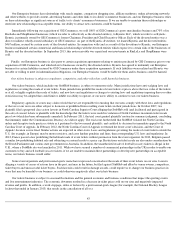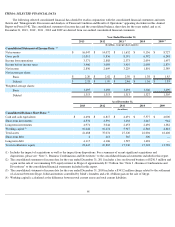eBay 2013 Annual Report Download - page 55
Download and view the complete annual report
Please find page 55 of the 2013 eBay annual report below. You can navigate through the pages in the report by either clicking on the pages listed below, or by using the keyword search tool below to find specific information within the annual report.
could increase our effective tax rate. A number of U.S. states have likewise attempted to increase corporate tax revenues by taking an expansive
view of corporate presence to attempt to impose corporate income taxes and other direct business taxes on companies that have no physical
presence in their state, and taxing authorities in foreign jurisdictions may take similar actions. Many U.S. states are also altering their
apportionment formulas to increase the amount of taxable income/loss attributable to their state from certain out-of-state businesses. Companies
that operate over the Internet, such as eBay, are a target of some of these efforts. If more taxing authorities are successful in applying direct taxes
to Internet companies that do not have a physical presence in the jurisdiction, this could increase our effective tax rate.
Our developer platforms, which are open to merchants and third-party developers, subject us to additional risks.
In 2009, we launched the PayPal Developer Platform to enable third-party developers to access a wide variety of PayPal product and
programming code specifications and to connect to select PayPal payment application programming interfaces (APIs). We also began providing
a software development kit (SDK) for building mobile payments applications, and enabling third-party developers to access certain APIs with
respect to our Marketplaces platforms. In August 2011, we acquired Magento, Inc. (now X.commerce, Inc.) which includes an open platform for
merchants and developers. In March 2013, we announced enhanced SDKs and API tools for the PayPal platform, with a particular focus on
developers of mobile applications. There can be no assurance that merchants or third-party developers will develop and maintain applications
and services on our open platforms on a timely basis or at all, and a number of factors could cause such third-party developers to curtail or stop
development for our platforms. In addition, our business is subject to many regulatory restrictions. It is possible that merchants and third-party
developers who utilize our development platforms, APIs and SDKs could violate these regulatory restrictions and we may be held responsible
for such violations, which could adversely affect our business.
There are risks associated with our indebtedness.
As of December 31, 2013, we had approximately $4.1 billion of senior unsecured indebtedness and no indebtedness outstanding under our
$2.0 billion commercial paper program, although from time to time we have made substantial borrowings under our commercial paper program
and may do so in the future. We also have a $3.0 billion revolving credit facility, under which we maintain $2.0 billion of available borrowing
capacity in order to repay commercial paper borrowings in the event we are unable to repay those borrowings from other sources when they
come due. As of December 31, 2013, no borrowings or letters of credit were outstanding under this revolving credit facility and, accordingly,
$1.0 billion of borrowing capacity was available for other purposes permitted by this credit facility.
We may incur additional indebtedness in the future, including under our commercial paper program and revolving credit facility or through
public or private offerings of debt securities. Our outstanding indebtedness and any additional indebtedness we incur may have significant
consequences, including, without limitation, any of the following:
Our ability to make payments of principal of and interest on our indebtedness depends upon our future performance, which will be subject
to general economic conditions, industry cycles and financial, business and other factors affecting our consolidated results of operations and
financial condition, many of which are beyond our control. If we are unable to generate sufficient cash flow from operations in the future to
service our debt, we may be required to, among other things:
Such measures might not be sufficient to enable us to service our debt. In addition, any such financing, refinancing or sale of assets might
not be available on economically favorable terms or at all.
53
•
we will be required to use cash reserves to pay the principal of and interest on our indebtedness;
•
our indebtedness and leverage may increase our vulnerability to adverse changes in general economic and industry conditions, as well
as to competitive pressure;
•
adverse changes in the ratings assigned to our debt securities by credit rating agencies will likely increase our borrowing costs;
• our ability to obtain additional financing for working capital, capital expenditures, acquisitions, share repurchases or for general
corporate and other purposes may be limited; and
•
our flexibility in planning for, or reacting to, changes in our business and our industry may be limited.
•
repatriate funds to the U.S. at substantial tax cost;
•
seek additional financing in the debt or equity markets;
•
refinance or restructure all or a portion of our indebtedness;
•
sell selected assets; or
•
reduce or delay planned capital or operating expenditures.
























